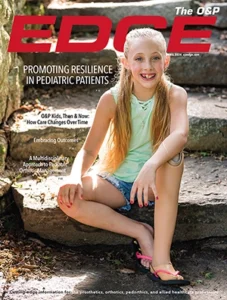
While fitting hundreds of cranial remolding orthoses a year, I have encountered confounding problems that are more time-consuming to address than fitting helmets on wiggly infants. These problems are certainly not localized to my area of Texas but may vary in severity depending on your region. I am talking about late referrals, helmet coverage confusion and denials, and helmet misinformation. Each of these issues significantly affects our cash flow, our outcomes, and our patients’ quality of life, but are rarely addressed in detail in cranial education seminars and courses.
When I was a newer cranial orthotist in charge of our region’s cranial care, these issues seemed out of my control. Working with hundreds of frustrated and upset parents spurred me into an investigation. Unfortunately, not everything can be solved solely with hand skills and clinical knowledge. In this cranial spotlight article, I would like to share some solutions to these problems.
My goal is for cranial orthotists to utilize the following resources to help improve their business and outcomes. The craniofacial community is small, and the more we collaborate, the more we progress as a medical field. Although these resources are not comprehensive, I aim to create a starting point to improve your clinic flow and patient care.
Late Referral Challenges and How to Improve Access to Cranial Education
A common issue most clinicians face is pediatricians referring patients who are too old. There have been several studies demonstrating that four to six months of age is the ideal time window for helmet referrals.1-4 Yet again and again, I am faced with a hard conversation when an infant ten months or older is in my office for evaluation.
In this situation, the parents were often the first to notice the head shape deformity and brought it up with the infant’s pediatrician multiple times. The pediatrician may have told the parents to reposition and that it would simply resolve itself. By ten months of age (or older) the parents notice no improvement, so the pediatrician finally refers them, only to encounter further delay while we await insurance authorization. Insurance authorization can take several weeks (even longer if appeals are required), which seems a lifetime when dealing with the rapidly closing window for helmet treatment. Stressed out parents often ask me why they were forced to wait, but I do not have a good answer for them. I dread these conversations, as I can offer nothing but sympathy. Furthermore, the parents have now lost trust in their child’s pediatrician.
You would be amazed at the misconceptions that exist about cranial remolding treatment. For example, I once had a referral from a pediatrician who thought helmets should be fitted up to 18 months of age. They had this misunderstanding due to the Food and Drug Administration’s stipulation that helmets could be worn until 18 months of age. Granted, this is sometimes the case for post-operative synostotic cases, but rarely in positional plagiocephaly. “Helmets don’t work” is sometimes heard from referrals as well, which is a misconception due to the notorious 2014 BMJ study.5 “Orthotists will put everyone in a helmet” is another example of confusion that needs to be addressed in detail.
Solutions for Physician Education
I recommend reaching out to your existing and potential referrals. Provide them with brochures, pamphlets, and other educational information. You can also request a brief meeting to review key topics. Follow-up meetings have an added benefit of keeping you on your referring physician’s mind. If your referral has a regular cranial clinic, ask to attend one and be present for any questions. Some larger facilities may even benefit from a continuing education course offered by several different organizations, including the American Academy of Orthotists and Prosthetists and Orthomerica. (See Figure 1 for educational resources for providers and parents).
Solutions for Physician Workflow
Many physicians are incredibly busy and writing supporting documentation in a timely fashion can prevent insurance denials. To assist with this issue, I distributed an overview of what the most common private insurance policies require and asked the referring providers to include these in their notes. All my referring providers were more than happy to comply. They added the necessary measurements (cephalic index and cranial vault asymmetry) in addition to clearly documenting the amount and type of repositioning. This is now quick and easy since they embedded the exact phrasing needed into their notes template. We even added the information required to fulfill detailed written order (DWO) requirements (e.g., S1040 Cranial Remolding Orthosis, Quantity one) into every prescription (See Figure 2). This goes for you too; the closer your notes are to payer requirements, the easier it is for them to find what they are looking for and approve. Bold and highlight the key phrases listed in the policy. I then request these notes from the physician via fax and submit them along with my notes. This has decreased our insurance rejection rate significantly and decreased our approval turnaround time by weeks.
This may seem like a lot of work for you and the referring provider up front, but you will have a well-oiled machine with reduced complaints, decreased waiting time, and decreased denials in no time. In addition, these changes will increase awareness, empowering pediatricians with accurate cranial orthoses information, thus improving their relationship with parents. Remember, you are the interested party; implementing these changes can improve patient outcomes, increase word-of-mouth referrals (parents and pediatricians talk) and increase work-in-progress turnover (therefore increasing revenue).
Figure 1. Education resources for providers and parents
|
|




